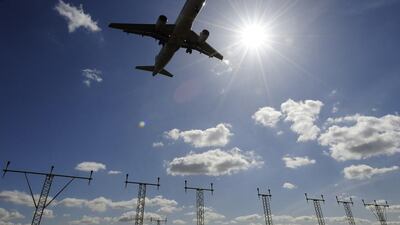Airlines in the Middle East witnessed a slowdown in passenger demand in July, despite overall growth in the peak summer travel period, the International Air Transport Association said on Monday.
Air passenger demand in the region grew by 4.8 per cent year-on-year in July, down from the 11.2 per cent growth recorded in June – but this is "mainly attributable to volatility in the data a year ago", the trade body said, without giving further details.
The region has been negatively impacted by several policy measures over the past 18 months, including travel restrictions for passengers from Muslim-majority nations, Iata said.
In March 2017, the United States restricted the use of electronic devices on US-bound flights from 10 Middle East airports citing security measures to prevent terrorist threats. The four-month ban, one of the controversial travel restrictions imposed by President Donald Trump’s administration, slashed demand for US flights on regional carriers. The ban was reversed in July last year after regional airports implemented new security measures approved by the US.
July capacity for Middle East airlines climbed 6.5 per cent compared to a year ago and the load factor dropped 1.3 percentage points to 80.3 per cent.
Overall, July saw healthy passenger demand, with average growth across all world regions standing at 5.3 per cent, although there was a decline from 8.2 per cent in June, Iata said. Asia-Pacific airlines recorded the fastest growth, with traffic rising 7.5 per cent compared to June growth of 9.6 per cent.
_______________
Read more:
Middle East cargo growth outstrips rest of world in July, says Iata
Middle East air passenger demand growth slows in May
Iata asks governments to release $5bn in airline revenues
_______________
Monthly capacity (measured in available seat kilometres) increased by 5.5 per cent year-on-year and the load factor rose 0.6 percentage points to a record high of 85.2 per cent.
"The second half of the year got off to a solid start, as the industry posted another month of solid traffic growth," said Alexandre de Juniac, Iata's director general and chief executive. "The record load factor shows that airlines are becoming even more efficient in terms of deploying capacity to meet demand."
However, rising costs – particularly fuel – will likely limit the stimulus expected from lower airfares, he added. “Therefore, we do expect to see a continued slowing of growth compared to 2017.”
Globally, total revenue per passenger kilometres rose 6.2 per cent, compared to the same month last year. “While this was down from 8.1 per cent year-over-year growth in June, it nevertheless marked a solid start to the peak passenger demand season,” the organisation said.
Mr de Juniac also urged the European Commission, its member states and air navigation service providers to eliminate European bottlenecks that prompted strikes and delays in July. “Air traffic capacity has not kept pace with demand and some controllers used the opportunity of the peak traffic period to launch strikes and work slowdowns,” he said.

